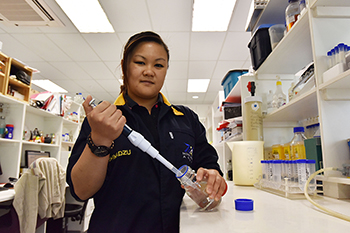Latest News Archive
Please select Category, Year, and then Month to display items
25 April 2022
Photo Jan van der Walt
 From the left are Eduan du Plessis (Bachelor of Commerce in Accounting and recipient of the SAIPA Prize for Best BCom third year student in Accounting), Johanco Viljoen (Bachelor of Science: Botany and Zoology), Louis van der Walt (Bachelor of Accounting), and Thinus Greyling (Bachelor of Commerce: Investment Management and Banking).
From the left are Eduan du Plessis (Bachelor of Commerce in Accounting and recipient of the SAIPA Prize for Best BCom third year student in Accounting), Johanco Viljoen (Bachelor of Science: Botany and Zoology), Louis van der Walt (Bachelor of Accounting), and Thinus Greyling (Bachelor of Commerce: Investment Management and Banking).
Seventeen years of friendship, with four degrees among them. This is what friends Eduan du Plessis, Johanco Viljoen, Louis van der Walt, and Thinus Greyling celebrated during the University of the Free State’s April graduation ceremony. The four friends – who started their academic careers together at Grey Pre-Primary in 2006 and matriculated at Grey College in 2018 – obtained qualifications during the graduation ceremonies of the faculties of Natural and Agricultural Sciences and Economic and Management Sciences.
The impact of personal care products on water resources in the Free State
2015-12-14

Jou-an Chen
Photo: Charl Devenish
|
Water is of the utmost importance in personal hygiene. Most people can hardly have a day go by without taking a shower in the morning and at night. However, it is this very habit that is increasingly polluting the water resources in South Africa.
Contaminants found in pharmaceutical and personal care products have been accumulating in water masses in recent years. These contaminants especially refer to hormones in medication, as well as colouring agents and fragrances used in soap, shampoo and body lotions.
“Little information and data are available on the prevalence of these contaminants, and on how high the level of pollution really is,” says Jou-an Chen, researcher in the Department of Microbial, Biochemical and Food Biotechnology at the UFS.
Her research particularly focuses on the prevalence and impact of those contaminants.
“Because these substances have not been properly investigated, we are not sure how widely it occurs and whether it is harmful to the environment. It was precisely the lack of information that has inspired me to investigate further.”
“If we could identify the contaminants and what it is doing to the environment, it could make a valuable contribution to directives on water quality standards.”